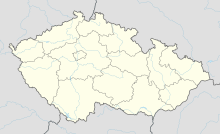Budeč u Zákolan
Budeč is an early medieval castle in the Czech Republic . It is located 17 kilometers northwest of today's center of Prague near the municipality of Zákolany in the Okres Kladno . The Rotunda of St. Peter and Paul is the oldest building in the Czech Republic that is still in use today.
description
Coordinates: 50 ° 11 ′ 28 ″ N , 14 ° 14 ′ 39 ″ E
The castle is located opposite the village of Kováry on the left side above the valley of the Zákolanský potok on an elongated hill that rises to 260–280 m above sea level . increases. It is protected on three sides by steep slopes. The difference in altitude between the castle area and the surrounding terrain is up to 60 meters.
The fortification, which is still clearly visible today, was in two parts. The inner wall enclosed a three hectare acropolis in which a fortified prince's seat, two church buildings and other residential and farm buildings were proven. The outer bailey , which was also fortified , took up an area of over 19 hectares. Here, too, there were settlements, some of which were sunk and some of which had been built above ground on stone foundations. There were also three larger burial sites on the site. One of them contained a mass grave in which 33–50 mostly young men who died violently were buried. A connection with a warlike action is assumed to be probable, but the grave cannot yet be reliably dated.
The fortification itself consisted of a wooden structure that was filled with clay. A stone wall was built on the front and the back was supported with stakes. Both the inner and outer defensive walls were expanded and expanded several times. After the last reconstruction at the end of the 10th century, the Acropolis was surrounded by a 13 meter wide and 700 meter long fortress wall, the outer fortification reached a length of 1.5 kilometers.
history
The hill had been fortified since the younger Bronze Age . This first phase of construction was completely covered by the early medieval castle complex, the foundation of which dates back to the end of the 9th century and is attributed to one of the early Přemyslid rulers. Either the first historically attested Přemyslid prince Bořivoj or his son Spytihněv could be the client . Along with Prague and Levý Hradec, Budeč was one of the central main locations of the so-called Přemyslid domain, i.e. the immediate sphere of influence of the ruling house. It is one of the few castles from this period that has found its way into contemporary written sources. The Christian legend from the end of the 10th century mentions the construction of the Church of St. Peter. Other legends tell that Saint Wenceslas was taught from the Psalter around 919–920 in Budeč and received his first training in reading and writing. From this information, in later centuries, especially in the chronicle of Václav Hájek z Libočan from the 16th century, the existence of a "school" in the sense of a supraregional educational center in Budeč was derived. However, this is a speculation that cannot be confirmed either from the written or from the archaeological sources.
The castle retained its strategic importance until the end of the 10th century. Then it fell into disrepair. The prince's seat was given up before 1050, and the other settlements abandoned in the 12th century. After that, only the churches and the cemetery remained in use.
In the 20th century, Budeč became a popular Catholic pilgrimage site . Two pilgrimages have taken place every year since 1990: one on the feast of Peter and Paul on June 29th and the second on the feast of St. Wenceslas on September 28th.
The area has been a national cultural monument since 1962 .
Sacred buildings
The Acropolis of the Přemyslid Castle had two sacred buildings: a St. Mary's Church and the rotunda of Saints Peter and Paul.
The Church of the Virgin Mary was an oval structure from the middle of the 10th century. It was demolished at the end of the 18th century. Its former floor plan is marked today by laid stone slabs.
The rotunda, which is still preserved today, was founded by Prince Spytihněv according to the Christian legend and consecrated to St. Peter. Archaeological research confirmed that the pre-Romanesque building dates from the late 9th century. This makes the church the oldest preserved building in the Czech Republic. Its slightly irregularly round ship measures over eight meters in diameter and tapers slightly towards the top. Most of it consists of the original building fabric. A rectangular Romanesque tower was added in the 12th century . During this time, the patronage was probably extended to include St. Paul. A choir was added in 1585 and a sacristy , also rectangular, in 1663 . The interior was destroyed in a fire in 1876; only a Renaissance pulpit from 1585 has been preserved.
literature
- Michal Lutovský: Po stopách prvních Přemyslovců . Volume 1, Nakladatelství Libri 2006, ISBN 80-7277-308-9 .


